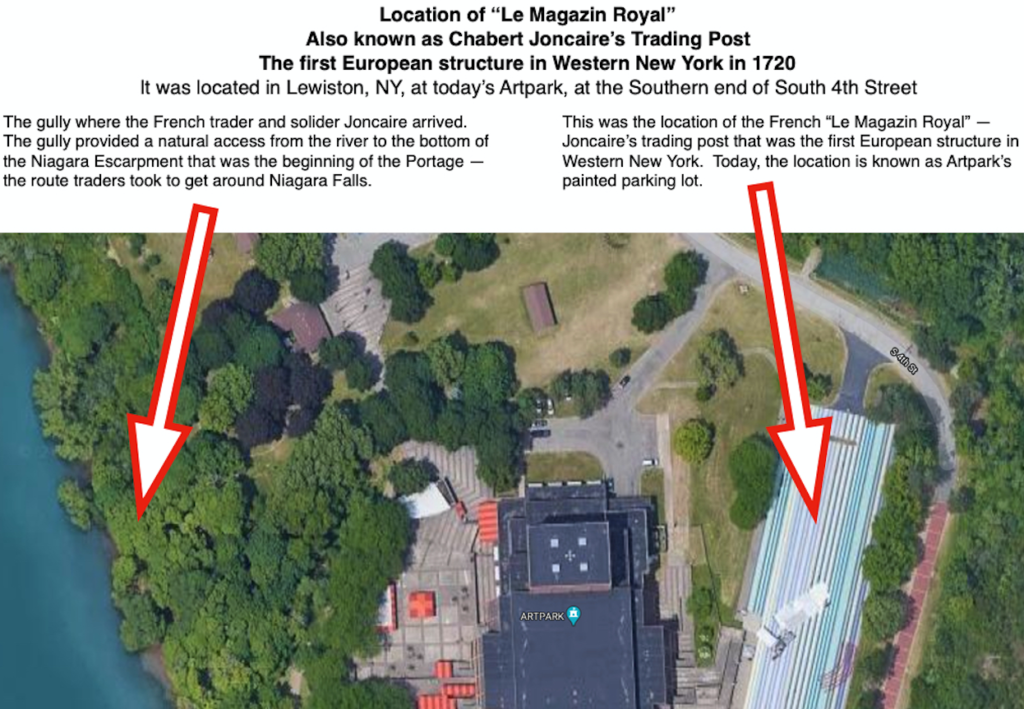
aka Joncaire’s Trading Post
Western New York’s First European Settlement
In May of 1720, French trader, solider and frontier diplomat Louis Thomas Chambert de Joncaire, age 50, arrived at the Lower Landing of the Niagara River (in today’s Lewiston, NY) to establish a house of trade. Naming the structure Le Magazin Royal, Joncaire intended the post become a center for political, cultural and economic interaction between the Seneca, Mississauga and French. He also wanted to keep the rival English out of the region.
Le Magazin Royal was described as being 30 by 40 feet in size and built of bark. It stood where Artpark’s Parking Lot C is currently located. The structure was erected near the head of the gully that allowed access to the Lower Niagara River and marked the northern terminus of the strategic Niagara Portage, a trail that bypassed the unnavigable Niagara Falls.
Nearby stood a Seneca village that consisted of about 10 cabins. Seneca men living in this village were employed as porters by the French, carrying all manner of goods and furs over the steep incline that linked the upper and lower Niagara River. The Senecas knew the area as Duh-jih-heh-ah or “walk on all fours” because traversing the Niagara Escarpment from the river to the top of the escarpment was a hard climb.
Joncaire had spent the previous winter at Seneca towns near Canandaigua and Geneva, New York, seeking permission to erect a trading post on the Niagara River. In early May, he arrived at Fort Frontenac (Kingston, Ontario) claiming that tribal leaders had granted leave to proceed. He quickly loaded a canoe with trade goods and set off for Niagara, arriving in mid-May. He soon began construction of Le Magazin, possibly aided by local Senecas.

Reports of Joncaire’s activities soon reached New York authorities. They dispatched a Dutch interpreter named Lawrence Claessen, accompanied by three civil chiefs, to demand that Joncaire tear down the structure. When Claessen’s party reached the site, Joncaire had departed, leaving 24 year old Louis LaCorne in charge. Claessen accosted LaCorne, who refused to demolish the building. Claessen then returned to Seneca Castle (near Geneva, New York) to discuss the matter. Joncaire arrived there shortly after and persuaded Native leaders to take no direct action on the matter. That winter, just two Frechmen remained at Le Magazin, an indication that the post depended entirely upon the consent of the local Seneca for its existence.
Until 1726, when the French built Fort Niagara at the mouth of the Niagara River in today’s Youngstown, NY, Le Magazin Royal was the primary contact point on the Niagara River among three nations — the French, Seneca and Mississauga. In addition to trade, the site was a venue for councils, dancing, feasting and singing as described by 38-year-old Jesuit named Pierre Francois-Xavier de Charlevoix.
Joncaire was born in Saint-Rémi de Provence, near Arles, France about 1670 and died at Fort Niagara on June 29, 1739.
Le Magazine Royal was destroyed by fire in 1741. It is known as the first white man’s settlement in Western New York and it paved the way for trade and commerce along the Great Lakes. On July 26, 1759, the British took control of the area with the British victory at the Battle of Fort Niagara.
In 1998, the The National Park Service declared this location a National Historical Landmark and erected a plaque which states:
“Lower Landing Archeological District has been designated a National Historic Landmark. This site possesses national significance in commemorating the history of the United States of America. The archeological remains of Joncaire’s trading post (1719-1741) and other archeological resources document inter-cultural relations at this key point within the colonial Niagara historic district.”
